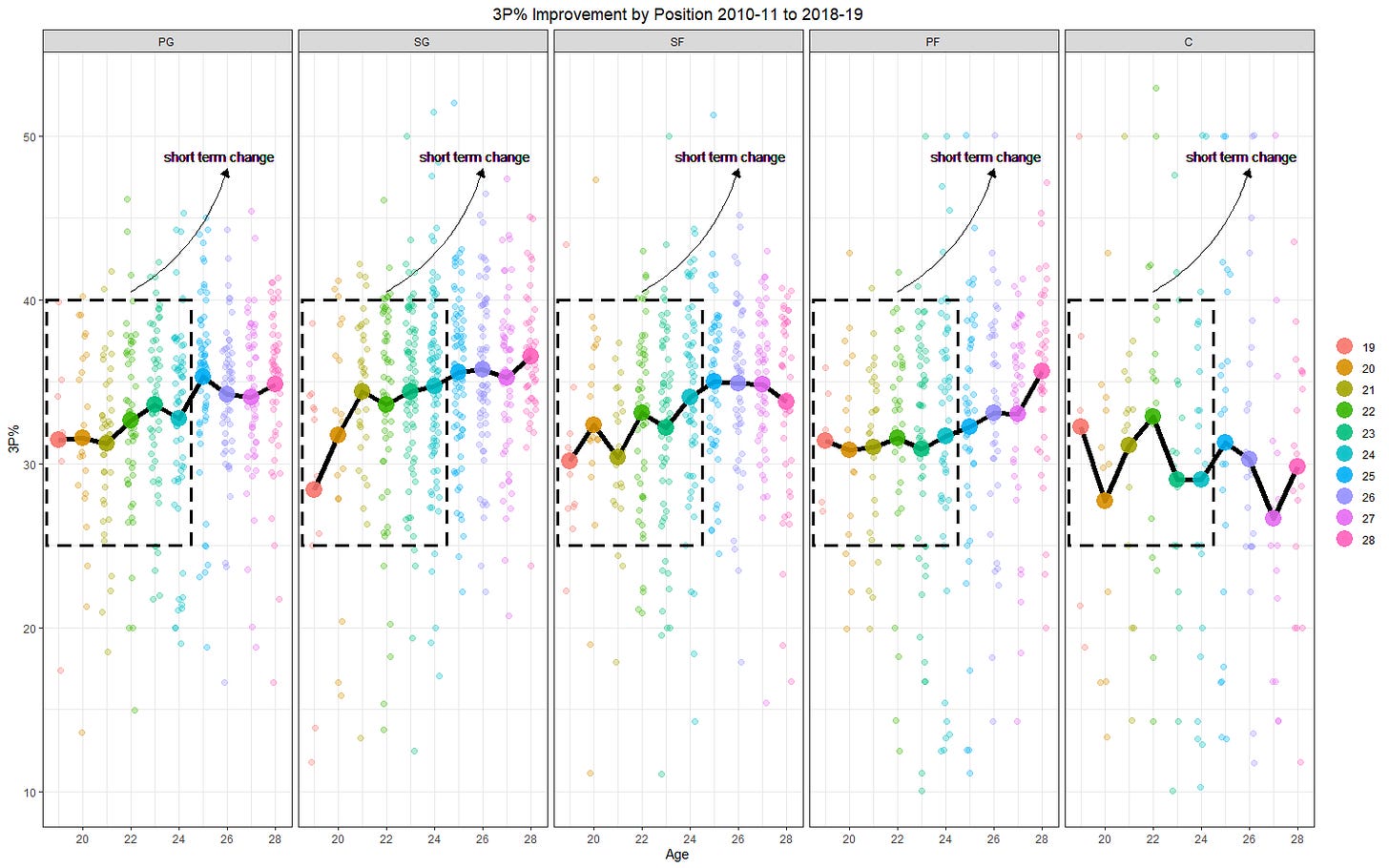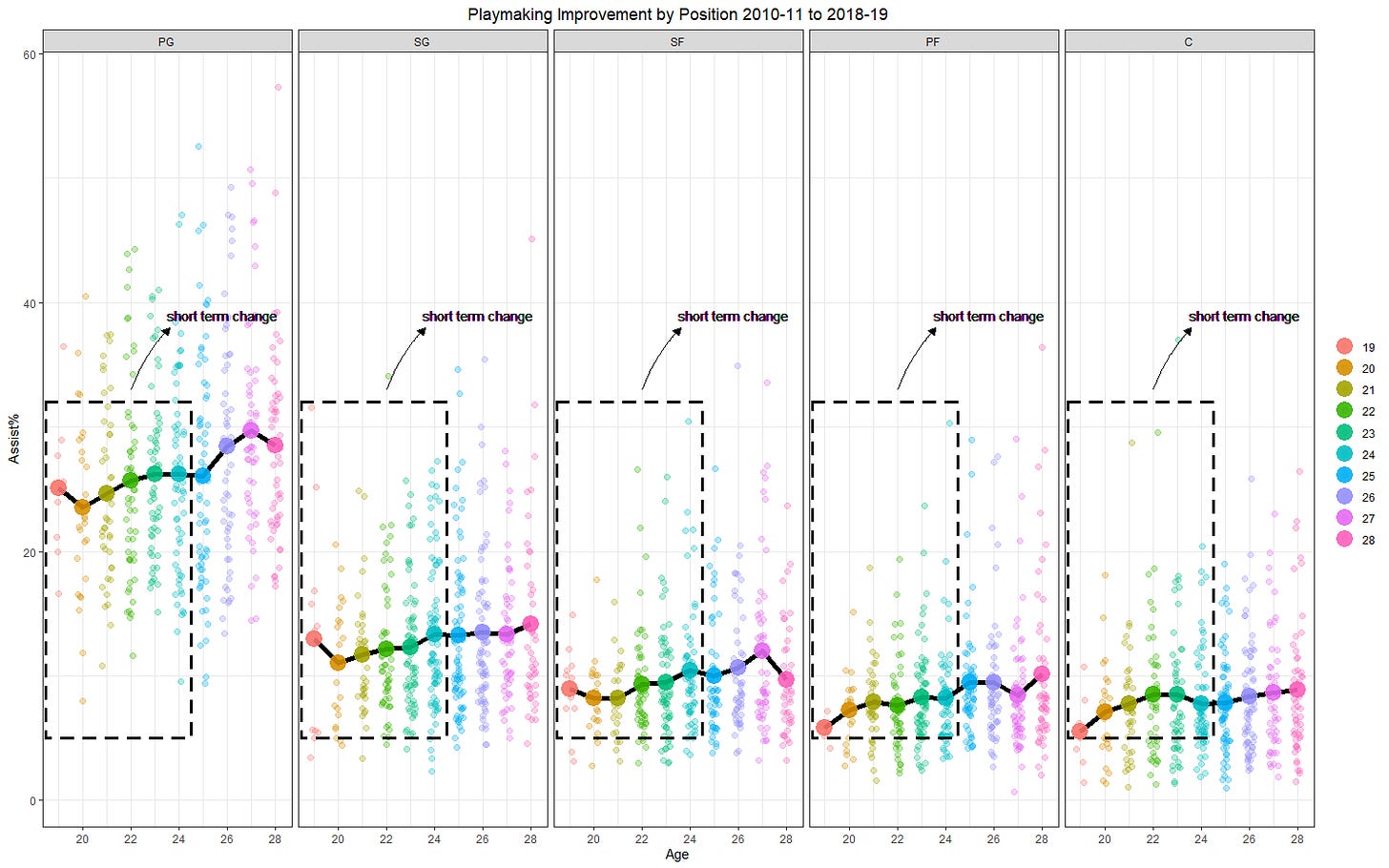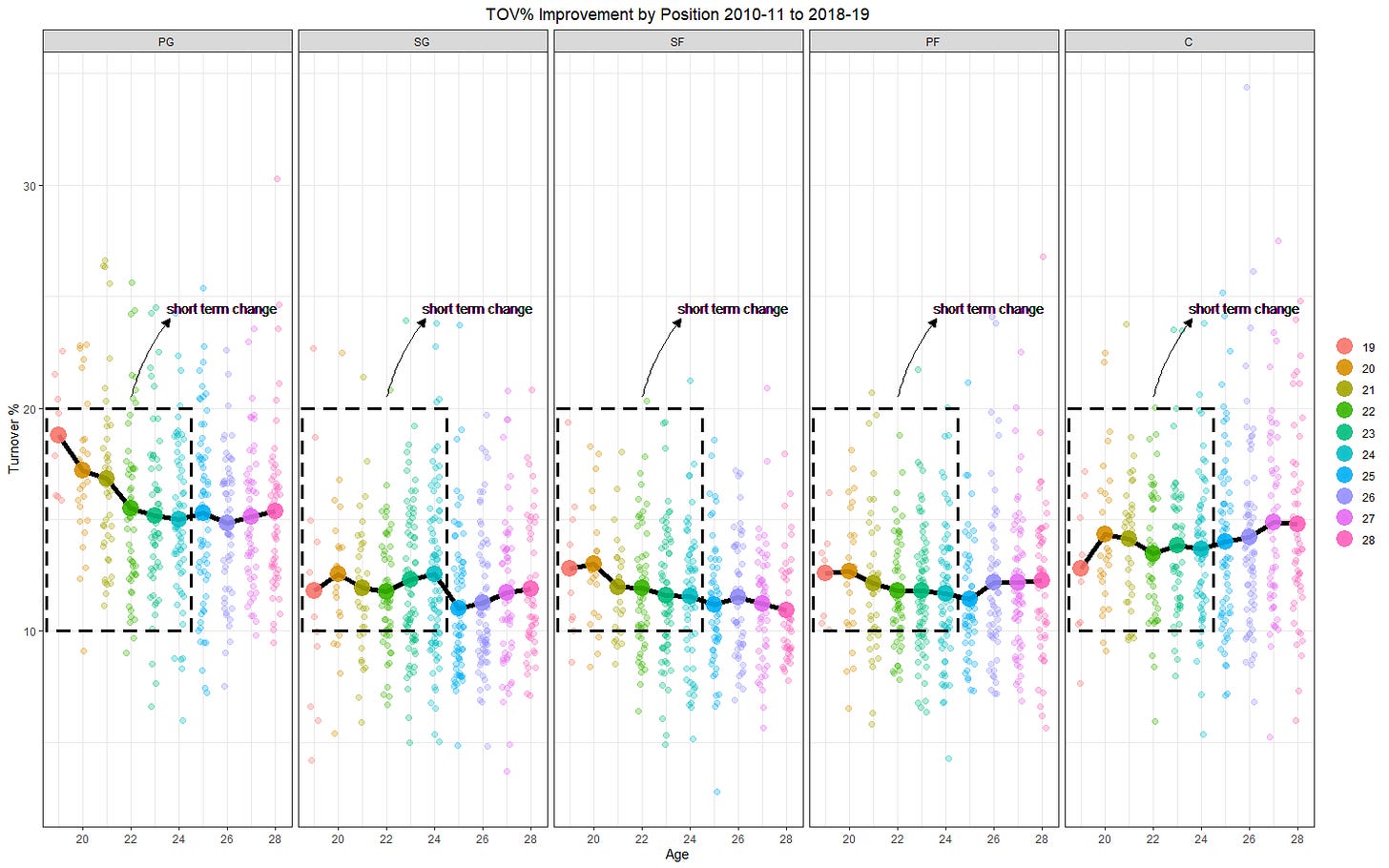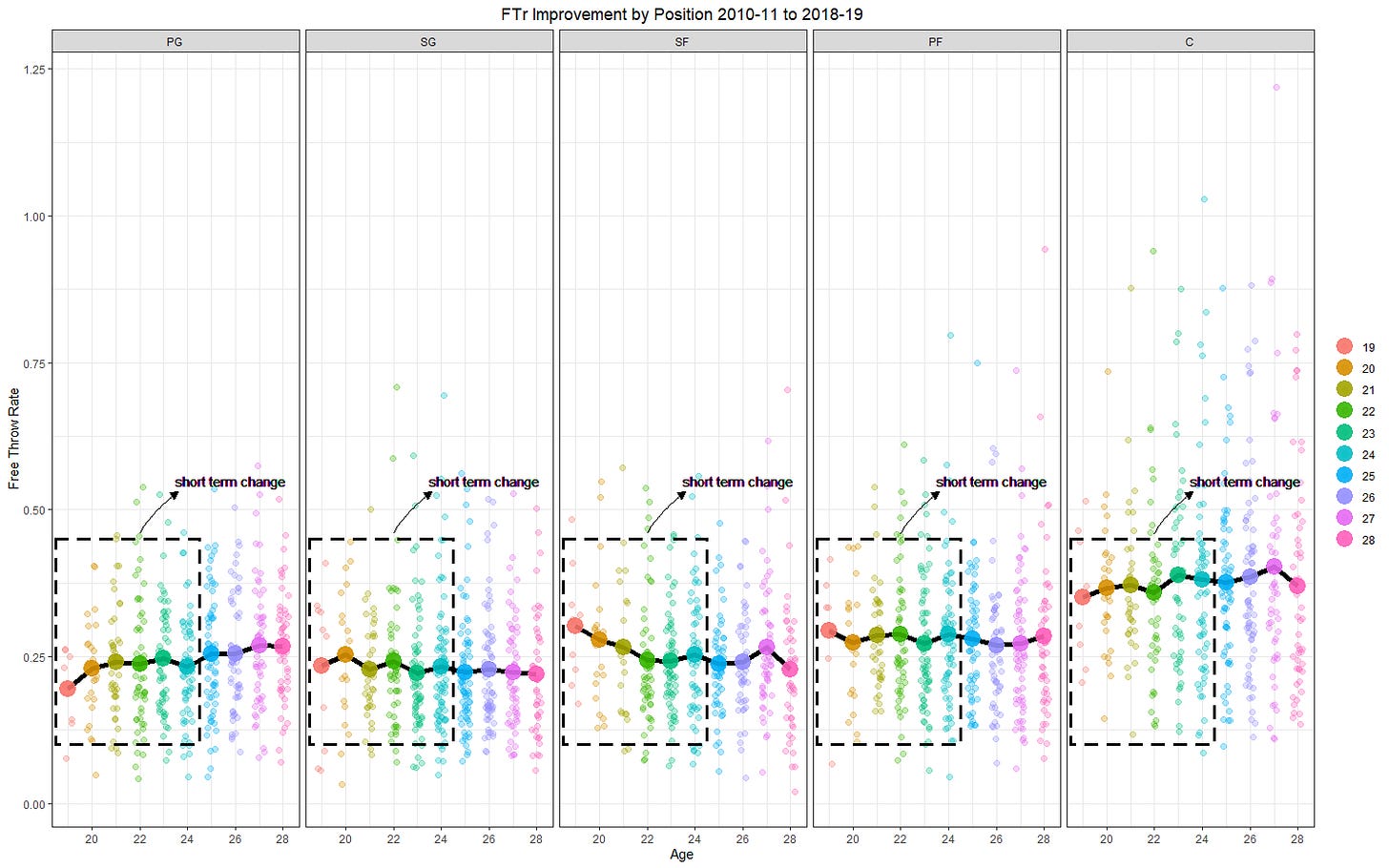NBA Swing Skills: Which Weaknesses are Weakest?
A deep dive into which skills prospects tend to improve easiest
What is a swing skill? In NBA terms, a ‘swing skill’ is typically a skill (think shooting, dribbling, finishing, etc.) that could determine the degree of success to which a player will succeed in the league. If the player fails to improve the skill, it could mean a vastly reduced role or even loss of a roster spot. However, if the player improves this skill, it could earn them tens of millions of dollars, a bigger role in the league, and stardom. Hence, the term ‘swing skill’. The success of the player hinges on the developmental swing of this skill.
It’s very rare for a prospect to have no weaknesses heading into the NBA draft. Scouts often have to project their development in numerous areas of the game. Each scout likely has a different opinion on which skill is the easiest to improve.

This tweet and this article (shoutout @TylerKnowsBall and @EZ_hoops) served as the inspiration for this piece. Each person that tried to rank swings skills had a slightly different opinion than the rest. So, using data from Basketball Reference, I sought out to answer the question myself.
How I did it
I took data starting from the 2010-11 season and ending with the 2018-19 season (pre-covid, to avoid wonky shooting results from fanless seasons), and for each skill picked a stat(s) that can best quantify it. I then created a scatter plot of age vs. said skill in an attempt to provide qualitative evidence of how/if a player improved on the skill. All of this was split by position. If this sounds a little bit confusing, I promise you that it’ll be much easier to understand once you see the visualizations.
Shooting
I’m going to start with the skill with probably the greatest emphasis this past decade or so: shooting, specifically from 3 point land. It seems guards and wings have some rather clear and steady improvement in their shooting as they age, while bigs really don’t see much improvement. I’d say shooting is probably one of the better swing skills for a player to have. NBA staffs have great shooting coaches and it is a skill that can be improved with more reps. It’s also a skill that will receive a lot of focus in today’s game.
I want to note that I’ve specifically highlighted the growth of players from their age 19-24 seasons. I think it’s important to mainly pay attention to this area because some of the improvements that occur in the league as players get older can possibly be explained by bad (for the NBA) players being weeded out over time. For example, a player could enter the league and be a terrible shooter from age 22-24 before he finds himself without a roster spot. As a result, leaguewide shooting results for 25-year-olds will likely be higher (addition by subtraction). Obviously, this doesn’t denote any improvement that a player made and the results should be taken with a grain of salt. That being said, if there is clear and marked improvement seen throughout the early years, there are probably a good number of cases where a player improved their shooting and thus the league average for his age group.
It really is an imperfect science, especially with players entering the league at different times, but I do think that the results hold some weight and truth to them.
Playmaking
I looked at 2 stats to try and quantify playmaking, AST/USG% (to provide some context of the role a player was asked to play) and AST%. Both stats provided similar insight, indicating that players saw slight improvements in playmaking across the board. It does seem to me that bigs see the most improvement when factoring in USG%, but they obviously had the most room to improve.
Ball Security
There really is no good way to quantify handling, but not turning the ball over is definitely a part of it so I decided to just look at the improvement of ball security. It’s hard to look at this graph without immediately noticing the large improvements point guards seem to make as they get older and gain more experience. It’s always important to remember that young guards have a steep learning curve and this helps to remind us that mistakes are part of the process.
Finishing
This one might come as a surprise to some people based on the replies I saw in the tweet I linked earlier. Finishing at the rim seems to be a skill that players don’t really improve on throughout their careers. While this is true, point guards and bigs both draw fouls at a higher rate as they get older, which is another indicator of finishing skill.
Self-Creation
For self-creation, I looked at the share of players’ 2pt and 3pt makes that were unassisted. On 2s, guards see steady self-creation improvement as they age, while forwards and bigs seem to see little to no change. I’m not sure why PFs seem to have such a stark decline in self-created 2s, but I think it could be a product of their role being simplified + better decision making (not trying to force anything). On 3s, PGs once again see improvement, but this time SGs don’t. Once again, I think role simplification and improved decision making play a part in the change for both SGs and SFs, while bigs see little to no change as they age.
Defense
As has been well documented, there probably isn’t a single stat out there that is a good, holistic measure of NBA defense. That being said, insights can still be found from looking at steal and block rates while DBPM can at least provide somewhat of a benchmark for good defense. Interestingly, steal rates seem to improve for all players regardless of position. I’m thinking the cause of this can probably be attributed to an increasing understanding of how NBA offenses and defenses work. Players likely anticipate and recognize patterns better, allowing them to make smarter gambles for steals.
However, we see the opposite happening for block rates. Block rates all decline regardless of position. Once again, this can be attributed to smarter defense being played. Players, especially bigs, stop chasing blocks as they gain more defensive experience, opting instead for smarter rotations and contests. It’s also possible that a decline in athleticism can play a part in lower block rates.
Finally, DBPM increases for all players regardless of position and once again I think there is a simple explanation. Players simply play smarter defense as they gain more experience, especially bigs and PGs, who seem to see the most drastic improvement.
Athleticism
Athleticism was another hard skill to quantify, but looking at dunks is one way to try and do it. Across the board, athleticism seems to peak and decline early (as @EZ_hoops noted in his article) with the exception of centers who probably see little change due to the role they play as well as their size advantages.
Overall Impact
Finally, I’ll leave for you here how a player’s impact changes over time. It’s extremely noticeable just how much players can improve. I think this viz and the ones before it really help to hit home that we need to be more patient with younger players. Too often, I see players written off or counted out when their career is still extremely young. Already this year, we’ve seen the discourse around Jalen Green completely change even though he continues to flash the talent that got him picked so high in the draft. For guys drafted high like Jalen, their teams remain patient with them for a long time. Other guys aren’t as lucky, and I think teams often fall victim to results-based decision-making when evaluating their young guys.


Luckily, I think the league is improving on this as a whole. Teams are utilizing the G League more than ever before and I really think it’ll result in the development of players that may not have reached their potential in years prior.
Conclusion
Now that we know which skills are easiest to improve and whatnot, I want to go ahead and wrap this up by trying to answer the question that was posed. For each position, I’ll rank skills from hardest to easiest to improve based on the results I found earlier.
PG: athleticism, finishing, playmaking, defense, self-creation, shooting, ball security
SG: athleticism, finishing, ball-security, playmaking, self-creation, defense, shooting
SF: athleticism, finishing, self-creation, playmaking, defense, ball security, shooting
PF: athleticism, self-creation, finishing, shooting, ball security, playmaking, defense
C: athleticism, shooting, ball security, self-creation, finishing, playmaking, defense
Liked the article? Don’t want to miss a post? To keep seeing content like this, consider signing up for my free newsletter. With each post being sent directly to your inbox, you’ll never miss an article!















Great read. I would point out that players tend to work on select areas of improvement and those are whatever the positional need is (minus existing skills).